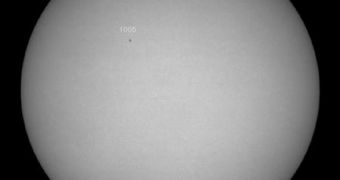The third sunspot in 3 weeks has just been discovered on the Sun's surface, which possibly means that its long dry period has finally come to an end.
As you may know from our previous articles, the star of our solar system has been going through a rough time, with both its winds and sunspots at a record low. However, at last, it's been three weeks that the sunspots have begun to show up again.
The Sun has a cycle of about 11 years, during which lows and highs are recorded on a regular basis. The cycle that began this year is the 24th recorded, and the newest spot that emerged – which is also the third and largest of this cycle – is dubbed 1005. This raises the sunspot monthly average for October to 2.3, with the possibility of increasing it to 2.6 if it survives for another day.
The sunspots are cooler zones, the size of a planet, where the Sun's magnetic fields break through its surface. Astronomers are anxious to see how the number of sunspots will evolve, as it will provide more data on the behavior of the next solar cycle that has just begun. As they say, the quicker the sunspots reappear, the more devastating the Sun's weather is going to be during cycle 24 occurring in the next decade.
However, at the moment, there's no need to worry because, since the current cycle started, there have been only been 3 sunspots observed during the last 3 weeks, while the rest of the year the surface of the Sun was spotless. “We're even looking at a possible fourth one that we can see in STEREO B spacecraft images,” says Doug Biesecker from the National Oceanic and Atmospheric Administration Space Weather Prediction Center in Boulder, Colorado.
The experts expect that more sunspots will decorate our star in the weeks to come, and monitoring them could finally settle the ongoing debate over the predicted behavior models of sunspots, some of which estimate a large yield, while others predict the exact opposite.

 14 DAY TRIAL //
14 DAY TRIAL //